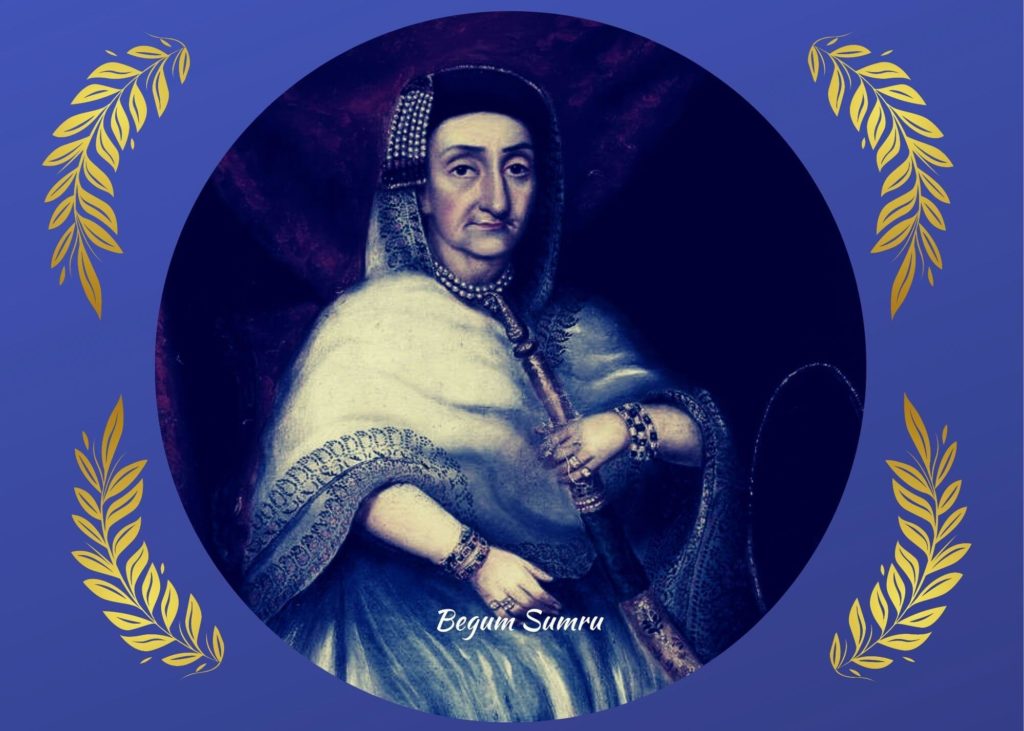Reading Time: 5 minutes
Intertwined with the incredible love story of a Tawaif, nautch girl, and a soldier, is a more than 200-year-old Catholic church in Sardhana, India. Dr. Roopali unravels the valour, magic, and miracle of a church, in the first part of her two-part story. An exclusive for Different Truths.

Love stories have always fascinated travellers. Millions upon millions visit the Taj Mahal. Its an enduring symbol of the eternal love of a king for his beloved queen. Still, very few know of the love story of a 14-year-old Tawaif (nautch girl), Farzana Zeb-un-Nissa and her European lover, Walter Reinhardt Sombre, a European mercenary soldier. And an adventurer in India.
Intertwined with their incredible love story is a more than two-hundred-year-old Catholic church in Sardhana, India.
A church dedicated to the Virgin Mary and built by a queen in memory of her beloved husband. Today, it continues to be a living, pulsating place of worship.
A church dedicated to the Virgin Mary and built by a queen in memory of her beloved husband.
About 19 kilometres northwest of Meerut, in Uttar Pradesh, lies Sardhana – a small, dusty little township. It’s about 70 kilometres from New Delhi, the capital of India, The only claim to fame is the two-hundred-year-old Church of the Basilica of Our Lady of Graces. Begum Farzana Joanna Sumru of Sardhana built the church, in 1709.
Until a year ago, the road from Delhi to Sardhana, via Meerut, afforded a painful car ride over stones, mud, and rubble. Today, a tarred smooth ride takes you there in less than an hour.
A Jostling Habitat
You enter a jostling habitat, having driven past green waterlogged paddy fields and a water canal. Soon, bales of merchandise and loads of potatoes piled on electric rickshaws confront you, as you meander through congested lanes. And past higgledy-piggledy houses painted green and pink.
Suddenly, you find yourself on a clear road leading you to the Church of the Basilica of Our Lady of Graces.
Suddenly, you find yourself on a clear road leading you to the Church of the Basilica of Our Lady of Graces. Encased behind massive wrought iron gates, the towering edifice of the domed church comes into view. It’s the Way of the Cross guiding you down tree-lined avenues amidst the serenity of the manicured green grass and the flowering trees.
In Sardhana, the love story of the tawaif – the nautch girl – and the soldier takes on an interesting turn. Legend has it that wanderlust had drawn adventurer Walter Reinhardt Sombre to India, in 1754. He was to serve as a private soldier in the French East India Company.
It is believed he was born in Strasbourg, but his nationality is quite uncertain.
It is believed he was born in Strasbourg. But his nationality was quite uncertain. Some say he was either Austrian or French or German or Swiss. All we know for sure was that he lived a courageous life. That of a mercenary soldier at a time when the Mughal Empire was declining.
Ruler of Sardhana
Quarrelling nawabs, rajas and rival foreign military and trading powers had presented a fertile opportunity for the fortune seeker. Reinhardt Sombre thus rose under the patronage of Shah Alam II to become the Civil and Military Governor of Agra. Soon, he was the ruler of Sardhana.

He had married Farzana – now Farzana Sumru – and operated from Agra, not too far away.
He had married Farzana – now Farzana Sumru – and operated from Agra, not too far away. He had found his way to India from a small, nondescript village in Germany, and was able to contend with the formidably diverse Indian political terrain.
Farzana was born to a Kashmiri Muslim family in Kutana, Meerut, in 1753. She was inducted into the tawaif entertaining tradition of a nautch girl. She was merely 14-year-old when Reinhardt Sombre met her at a kotha in Delhi’s crowded red light area, in Chowri bazaar. Then, she was performing for the King of Bharatpur.
For Reinhardt Sombre and little Farzana it was love at first sight.
For Reinhardt Sombre and little Farzana it was love at first sight. With deep faith in his love, Farzana managed to escape the constricting world of the tawaif. She accompanied her lover, and later her husband, Reinhardt Sombre to wherever his mercenary career took him. Intelligent and courageous, she joined him in many military skirmishes. And she proved her mettle as a warrior, becoming Begum Sumru along the way.
Begum Sumru
Reinhardt’s untimely death at 44-year-of-age made Begum Sumru the commander of the army. She led four thousand Indian and European professionally trained mercenary soldiers. Still madly in love with her husband, she fought with great courage against the British. She managed to negotiate a major deal with rampaging Sikh soldiers. The deal was so well received that the soldiers went peacefully back to Punjab.
The Mughal Emperor, Shah Alam II, treated Begum Sumru like a daughter, allowing her to inherit the principality of Sardhana.
The Mughal Emperor, Shah Alam II, treated Begum Sumru like a daughter, allowing her to inherit the principality of Sardhana. It is said she once saved Shah Alam’s life on the battlefield. She was rewarded with various titles and Shah Alam’s son, Akbar II, gifted her land at Chandni Chowk in Delhi. There she build Bhagirath palace.
Three years after the death of Reinhardt Sombre, in 1781, Begum Sumru embraced Catholicism. And she built the renowned church in Sardhana, dedicated to the Virgin Mary. They say the Virgin Mary appeared to her in a vision and called upon her to honour God and her husband.
The First Catholic Ruler
Thus, as Joanna Nobilis Sombre, she became the first Catholic ruler in India. Then, in 1793, she married a French commander by the name of Le Vaisseau, who worked for her. She survived many attempts on her life and many intrigues to benevolently rule Sardhana for 58 years.
Lord A W Bentick, Governor General of India wrote to her praising her charitable and philanthropic work.
Lord A W Bentick, Governor General of India wrote to her praising her charitable and philanthropic work. Her wealth, of immense proportions, was used for the benefit of her people. Begum Sumru, as she is still known, was buried here in the Church. In 1961, Pope John XXIII declared it a Basilica.
The Church of Our Lady of Graces is the landmark of Sardhana. And people of all faiths visit it with great reverence. It was built by Italian architect Major Anthony Regeheleni, entrusted by Begum herself. It took eleven years to complete.
Architecture of the Church
The architecture of the church is based on St. Peter’s Basilica in Rome, with some Indian architectural influence. Two spires, three Roman domes, and an elevated altar with a stained-glass dome create splendid viewing grandeur.
Italian sculptor Adamo Tadolini created eleven exquisite sculptures.
Its semi-precious stonework, a Greek colonnaded verandah and an elevated altar add to the splendour. Italian sculptor Adamo Tadolini created eleven exquisite sculptures. These were transported by ship from Italy to Kolkata. And then by bullock carts and boats to Meerut and Sardhana.
The sculpture depicts Begum Sumru on the throne, smoking a hookah in a durbar (court) with Europeans and Indians. We also see depicted Emperor Shah Alam II, giving her the Farman (decree) for Sardhana. She is with her adopted son David Dyce Sombre, and Diwan Rae Singh, the great grandfather of Pandit Motilal Nehru.
Miraculous Healings
You see large crowds of Hindus, Muslims and Christians visiting the Church and kneeling in prayer, no matter when you go, Its opulent gardens and grand solemn edifices suffuse it with a deep spirituality and awe. This Church holds a very sacred image of the Virgin Mary, which is considered to bestow miraculous healings.
… the Basilica of Kripaon ki Mata (Mother of Mercy and Grace). The Virgin Mary enshrined there is known to perform miracles.
Also known as the Basilica of Kripaon ki Mata (Mother of Mercy and Grace). The Virgin Mary enshrined there is known to perform miracles.
The divine gift of parenthood draws many to the shrine. “Mother Mary is generous here,” we are told.
Acknowledgement
Historical facts are credited to Wikipedia and brochures from Sardhana.
To be continued
Photos sourced by the author and visual by Different Truths
















